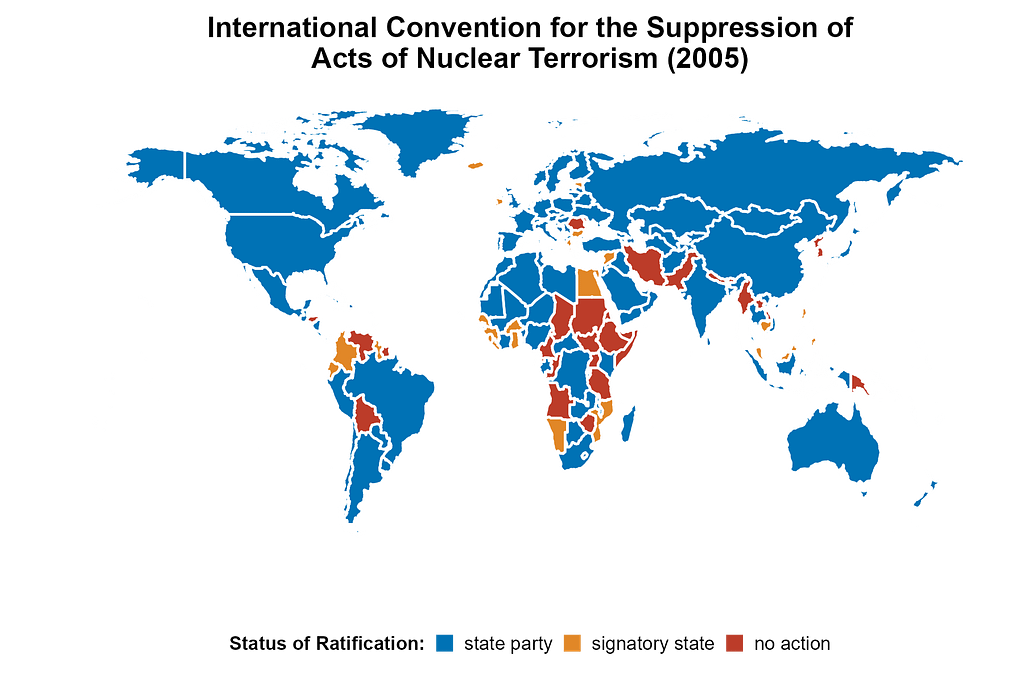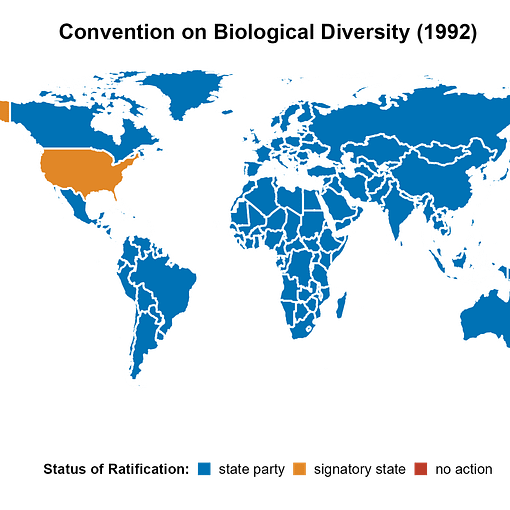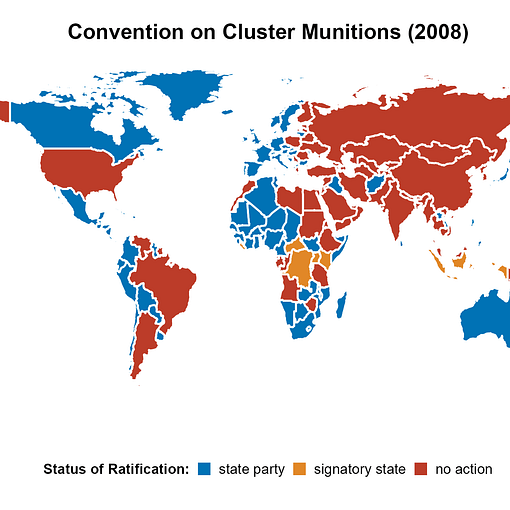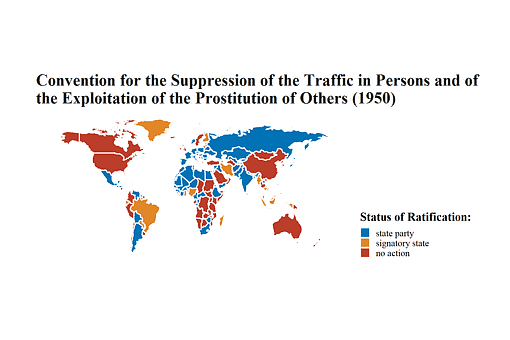SEAN BECKER & MACKENZIE PISANI
In this post, we assess the ratification status of The International Convention for the Suppression of Acts of Nuclear Terrorism. It was adopted in 2005 and came into force in 2007. The convention’s goal is to require states to criminalize the planning, threatening, or carrying out of acts of nuclear terrorism. It was the first counter-terrorism treaty negotiated and adopted following the terrorist attacks of September 11, 2001.
The following choropleth map, generated using the ggplot2 package for R, offers insights into the support among United Nations (UN) member states for this convention. By utilizing data from the UN Treaty Collection’s website, we categorize states into distinct groups. “No action” states are those that haven’t signed or ratified the treaty. A state party refers to those states that have ratified the treaty, while a signatory state pertains to those that have signed but not yet ratified the instrument.

While the convention has widespread support, it is important to highlight three significant problems. First, Pakistan and North Korea, two nuclear weapon states, have not signed or ratified the convention. Second, Israel, which many experts believe possesses a small arsenal of nuclear weapons, has signed, but not ratified the instrument. Finally, many developing states, especially those aligned with the Non-Aligned Movement (NAM), have not ratified the convention. They argue that the convention, rather than establishing a new regime to counter nuclear terrorism, reproduced an “archaic system of cooperation” based on the 1968 Non-Proliferation Treaty. While many non-nuclear weapons states wanted to use this instrument to promote nuclear disarmament, this would have prevented nuclear weapons states from supporting the agreement.
In her article, Page Willan highlights an intriguing aspect of the treaty—its predominant focus on addressing law enforcement practices related to potential nuclear terrorism. She underscores various reasons why this approach might not effectively combat such threats. These reasons include doubts about the deterrent effect of law enforcement punishments, particularly when perpetrators are indifferent to personal consequences. Additionally, the sheer difficulty of physically investigating a nuclear attack due to its massive destructive scale and the hostile aftermath contributes to the treaty’s perceived limitations.
These elements collectively contribute to the perception that the treaty lacks effectiveness in tackling the issue, leading to hesitancy among nations to ratify it. Thus, some advocate for a more robust treaty that directly confronts potential nuclear terrorist threats, a move that could have far-reaching global implications for the entire international community.
In summary, the map highlights the evident shortcomings of the International Convention for the Suppression of Acts of Nuclear Terrorism. The absence of ratification by countries such as Israel, Pakistan, and North Korea weakens the treaty, given their possession of nuclear weapons that could potentially be utilized beyond the treaty’s boundaries. Additionally, global reluctance to ratify stems from perceptions that the treaty is overly broad and lacks encouragement for disarmament efforts. With the lack of universal agreement, particularly among all nuclear-capable nations, the treaty stands significantly compromised.
Want to learn more about this legal instrument?
Data on this convention’s ratification status is available on the World Politics Data Lab’s GitHub page. The most recent dataset was uploaded to the repository on October 1, 2023.
For more information on the convention’s history and its current application, please refer to the following academic writings:
Joyner, C.C. (2007) “Countering nuclear terrorism: a conventional response,” European Journal of International Law 18(2): 225-251.
Willan, P. (2008) “The Convention on the Suppression of Acts of Nuclear Terrorism: An Old Solution to a New Problem,” Georgetown Journal of International Law 39: 527–550.
About the authors:
Sean Becker is a junior, majoring in Political Science and Spanish at Drew University.
MacKenzie Pisani is a junior, majoring in International Relations and Spanish and minoring in Education and Environmental Studies at Drew University.
Editor’s note: This post is part of a long-term project. Students enrolled in Drew University’s Semester on the United Nations, Principles in International Law, and International Human Rights have been and will be collecting data on the ratification status of treaties deposited in the United Nations Treaty Collection. For more information on this project and its learning goals, click here.



